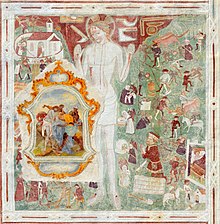St. Jacob's Church (Ortisei in Val Gardena)
The St. Jacob's Church is near the hamlet of St. Jakob in Ortisei in Val Gardena .
history
The St. Jacob's Church is located in the area of the ancient Troi Paiàn high trail , which once led from the Venetian over the Dolomite passes and through Val Gardena here - past the former Stetteneck Castle - into the nearby Eisack Valley . It is no coincidence that the church here has St. Jacob became the patron, the protector of pilgrims and hikers. The St. Jacob's Church is the oldest and actual mother church in the Val Gardena.
It is documented in a still-preserved letter of indulgence from August 18, 1283. Bishop Aegidius from Aemonia ( Laibach ) awarded it to all Christian believers who reverently visit the St. Jacob's Chapel in Staeteneke after confession (“convenientibus ad Capellam sancti Jacobi in Staeteneke ”), forty days indulgence. The document is significant because it refers to the fact that St. Jakob was certainly a pilgrimage destination as early as the 13th century and "in Staeteneke", i. H. is located in the territory of the Lords of Stetteneck, who were wealthy as ministerials of the Bishop of Brixen in Val Gardena. The year 1181 is carved in the bell tower. The church was first mentioned in a document in 1325 by Jakob von Stättenecke in the 13th century, probably expanded and dedicated to St. Jakob. According to a legend, wild birds decided the place of origin. In 1366 the roof of the church burned down after being struck by lightning. The church was renovated in 1440 in the late Gothic style and still retains this style externally.
The smallest and oldest bell of the church of Master Manfredinus, 14th century, is said to have been the bell of the castle chapel in Stetteneck and, according to the vernacular, was dug out of the Pinkan holes by a bull and used in St. Jacob's Church. During the First World War, she was shot and damaged by a soldier. It was erected on the church square in Ortisei after the Chapel of the Dead of War was built. The Gothic bell can now be viewed in the Luis Trenker cultural center, and a functioning replica hangs on the chapel of the dead. The large bell of St. Jacob's Church is engraved with the year of casting 1565.
Interior
Triumphal arch of the apse
Frescoes by the Brixen School from the second half of the 15th century on the arch (from left to right).
The Saint Ursula
The Saint Barbara
The St. Catherine
The Holy Dorothea
The nave is 11.30 m long, 7.75 m wide and 8 m high. The choir is painted with late Gothic frescoes from the workshop of Leonhard von Brixen . The baroque main altar comes from the artist family Vinazer , the altar sheet by the painter Franz Sebald Unterberger is a copy of the original in the Museum Val Gardena . The original baroque statues and the Lenten veil from the church can also be viewed in the Val Gardena Museum. On the outer wall there are two late Gothic frescoes depicting Saint Christopher and the suffering Christ. Further rococo-style frescoes depict the stations of the cross .
literature
- Tresl Gruber : The Church of St. Jakob, dedicated to St. Jakob and viewed from a historical artistic point of view , St. Ulrich around 1957. Translation from Ladin by F. Pr. (Franz Pugger)
- Margareth Runggaldier Mahlknecht, Karl Mahlknecht: Ortisei in Val Gardena - churches and church history. A text and picture documentation . Athesia Verlag, Brixen 1992.
- Eugen Trapp: Art Monuments of Ladinia. Val Badia. Val Gardena. Fassa Valley. Buchenstein. Ampezzo . Publishing house Istitut Cultural Ladin Micurà de Rü, San Martin de Tor 2003. ISBN 88-8171-044-7 , pp. 186-194.
Individual evidence
- ↑ The Count of Sacun
- ↑ Say St. Jacob
- ↑ Tobia Moroder, Stefan Planker: Magister Manfredinus me fecit , Museum Ladin Ciastel de Tor, San Martin de Tor, 2009. ISBN 88-89255-30-7
See also
Web links
- Entry in the monument browser on the website of the South Tyrolean Monuments Office
Coordinates: 46 ° 34 '24.2 " N , 11 ° 41' 39.3" E









